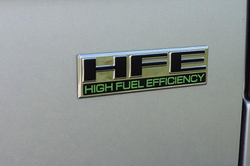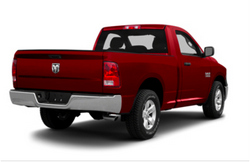Pickup Trucks Battle for Fuel Economy Leadership.

(Editor’s Note: This is the fourth in a series about vehicles with start-stop systems.)
Bragging rights and one-upmanship have long been a part of pickup truck marketing: Who has the most horsepower, the most stump-pulling torque, the biggest payload capacity and the most towing grunt.
But a new pickup bragging rights category has emerged – fuel economy.
It began in 2009 with General Motors’ two-mode hybrid system for the Chevrolet Silverado Hybrid and its twin toolbox, the GMC Sierra Hybrid (both now discontinued). Their EPA ratings of 21 mpg city/22 mpg highway and 21 mpg combined made them the pickup fuel economy kings.
Two years later Ford bragged that its F-150 pickup, with a new V-6 twin turbocharged 3.7-liter V-6 engine, delivered an EPA 23 mpg highway rating. Ford’s marketing, however, overlooked the F-150’s 17 mpg city and 19 mpg combined ratings.
For the 2013-model year, an all-new Ram 1500 pickup leapfrogged Ford and claimed fuel economy bragging rights with its all-new model. Powered by Chrysler’s 3.6-liter Pentastar V-6 engine, the new half-ton truck came through with a 17 mpg city/25 mpg highway rating – numbers that were unthinkable just five years ago.

Ram added icing on the cake with the HFE (high fuel efficiency) model. With a stop-start function, the HFE bumps city fuel economy to 18 mpg.
The 2014 Ram 1500 will continue with the styling and mechanical changes unveiled on the 2013 edition, Ram’s first sheet metal re-do since model year 2009. New for 2014 is a 3.0-liter turbocharged V-6 diesel that Ram says “is noticeably more efficient than all V-6 gasoline engines in the half-ton category.” (Ed. note: we’ll be testing the EcoDiesel as soon as one shows up in the test fleet, but we previewed this and other MPG moves recently.)
Ram’s Stop-Start System
An industry first for a non-hybrid full-size pickup, the Ram 1500’s start-stop is considered a “light start-stop” system. Ram says the system improves fuel economy by up to 3.3 percent, or an increase of about one mpg during city driving.
Stop-start operates automatically and doesn’t require any input from the driver. Electronics such as the radio, gauges and climate controls remain on, and the engine restarts automatically when the driver releases the brake.
System voltage is continually monitored through a battery sensor. If the battery’s charge is reduced, the truck will discontinue start-stop until the battery is recharged to an acceptable level.
The system monitors the brake-pedal position and vehicle speed over time to determine the appropriate situations to shut off the engine to avoid constant on/off cycling in heavy stop-and-go traffic. And a system-disable switch on the dash lets drivers turn off the feature should they desire.
Electrical System Upgrades
Due to additional high-use and electrical load demands placed on the starter, alternator and battery, these components have been upgraded for heavy-duty operation.
This includes a high-durability starter housed in a stronger case, heavy-duty flywheel teeth and a more robust starter solenoid.

Ram says the new starter was subjected to durability testing cycles more than 2.5 times that of a non-start-stop equipped unit – more than 300,000 on/off cycles.
The new battery features 800 amps with absorbed glass mat (AGM) technology. An upgraded 220-amp alternator also is included in the charging system.
When asked if start-stop was a move towards the electrification of vehicles, Ram spokesman Nick Cappa said, “Not entirely. We see it as a dedicated fuel saving technology. More interesting will be how truck customers will react.”
Under The Aluminum Hood
Start-stop is only a small part of the 2014 Ram 1500 HFE’s fuel economy story. Another Ram fuel-economy enabler is weight reduction, including an aluminum hood, which weighs 26 pounds less than the previous model. Combine that with a new, lighter frame, aluminum suspension pieces, revised bumper and lighter powertrain components, and the new Ram shed 143 pounds. Not what Ford managed with its new aluminum-intensive F-150, but still impressive.
That aluminum hood hides the biggest contributors to fuel efficiency, Chrysler’s Pentastar V-6 engine connected to a super-thrifty eight-speed automatic transmission, another pickup industry first.
Featuring variable-valve timing (VVT), the 3.6-liter naturally aspirated engine offers a hefty 305 horsepower and 269 pounds-feet of torque, while delivering 20 percent better fuel economy when compared to the previous 3.7-liter V-6 powertrain.
The eight-speed has widely spaced ratios with a super-low 4.71 first gear ratio for quick starts and two tall overdrive ratios on the top end. This range of gears translates to a good gear for highway fuel economy without sacrificing a low first gear for power.
Wringing out this kind of fuel economy improvement requires big and small changes. Just to name a few: A new electric power-assist steering reduces engine drag; thermal management quickly gets the engine and transmission to optimum temperatures; pulse-width modulation technology runs the fuel pump and cooling fan only as needed; low-rolling resistance tires; active grille shutters reduce drag as does a lower front valance.
Design Elements
In profile, the new Ram doesn’t look any different than the 2009-2012 generation. Up front, however, the “I wanna-be-a-big-rig” grille is larger and taller with crosshair bars that are now flush at the top and bottom of the grille surround.
Subtle changes include restyled headlights and LED turn signals/taillights.
Improved aerodynamics was a key goal in the Ram’s 2013 revamp. Ram says the truck has best-in-class aerodynamics, coefficient of drag (Cd) at 0.360. And that’s before adding a standard tonneau cover to the HFE model.
Inside, the Ram’s interior – already considered one of the best – even the lower trim levels including the HFE have upgraded materials and boast an attractive design. The 40/20/40 split folding bench seat is firm and comfortable, the steering wheel is appropriately thick and there are plenty of cup holders and storage cubbies.

A new gauge cluster includes a 3.5-inch vehicle-information screen and the gauges are clearly legible day or night.
The eight-speed automatic transmission uses a rotary dial in place of a floor or steering-column-mounted shift lever, not unlike that found on a Jaguar. Located on the dashboard above the driver’s right knee, the knob is well sized with groves for operating with thick gloves.
This new shifting device rotates easily through the traditional, Park, Reverse, Neutral, and Drive settings. Manual-type gear control is available via small steering-wheel buttons.
While amenities such as remote power everything, leather seating and touch-screen multimedia aren’t available for the HFE, the list of standard equipment covers most of the wants for buyers. These include power windows and door locks, cruise control, air conditioning, variable intermittent wipers and a six-speaker AM/FM stereo with USB/iPod connectivity.
Safety features include all the biggies: four-wheel anti-lock disc brakes, stability control, hill-start assist, front-seat side airbags and side curtain airbags.
Pricing
The 2014 Ram 1500’s HFE model has a sticker price of $30,090, including $1,195 destination charges. It is available only in a Regular Cab (two-door) 4×2 configuration with a short bed, the smallest full-size Ram 1500 pickup in the lineup. Four-wheel drive is not available on the HFE, nor is any other cab configuration or box length. Also, it has one of the smallest payload ratings at 1,430 pounds and one of the lowest maximum tow ratings, just 4,750 pounds.
If you’re looking for a basic half-ton regular cab pickup with no frills, the base Tradesman model can be had for $4,500 less and it offers identical highway fuel economy of 25 mpg and one mpg less in the city.
But if you want some creature comforts, the HFE is actually $215 less than the SLT version, which is the next step up from the Tradesman and is similarly equipped to the HFE.

Ram’s spokesman Cappa said it will be interesting to see how truck customers will react to the HFE. While it’s obviously not a heavy-duty work truck, fleet buyers such as municipalities would benefit from the HFE’s urban start-stop fuel economy and maybe even better the EPA rating. The same would apply to construction trades who work primarily in urban areas and don’t haul heavy loads or tow equipment.
And then there’s the consumer who just wants a pickup to throw some camping gear or bikes in the bed for weekend recreation and for trips to Home Depot so they can check off items on the “honey-do” list.
Whoever the buyer is, they’ll have a comfortable riding, fairly well equipped pickup with excellent fuel economy for a reasonable price.
[Ed. note: Why does one MPG matter? I’m sure many readers might think a one mpg improvement is barely worth mentioning in the world of 50 mpg hybrids and 100+ mpg plug-in hybrids. Well, it does matter in bigger vehicles like pickups and SUVs – more than you might think. It’s about fuel savings more than the mpg, which points up the shortcomings of measuring fuel efficiency in miles per gallon rather than the way the scientific world measures such things, i.e., in gallons per mile or even more telling, gallons per 100 miles. A Washington Post writer summed it up quite well last year, joining a chorus of those we really know how to measure things. Look at the one mpg gain through this lens – in an low-average annual use of 10,000 that one mpg turns into 33 gallons, which at the current local cost of $4+ is $130 saved. But more important is the non-linear relationship of mpg to gpm on relatively low mpg vehicles. A two or three-mpg improvement like the one offered with some of the new pickups, which again doesn’t seem like much, provides a significant bump since it represents a major improvement on a percentage basis. And given the work use of many pickups, the cost savings from increased fuel economy go right to the bottom line.]
Photos by the manufacturer
Posted April 26, 2014
Other related stories you might enjoy:
Pickups Pick Up MPG
Ford Sees Way To MPG Through Lightweighting
My Top 10 Cars & Trucks for 2014

0 thoughts on “Overview: 2014 Ram 1500 HFE With Start-Stop System”